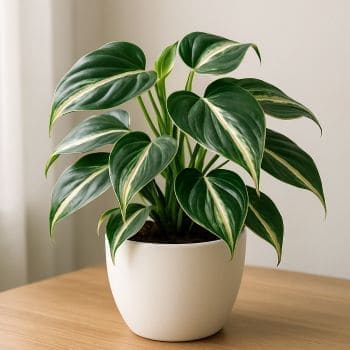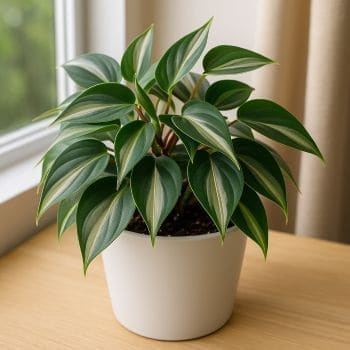Philodendron hederaceum ‘Silver Stripe’ Care & Growing Guide
Overview
Philodendron hederaceum ‘Silver Stripe’ is a striking variegated cultivar of the popular heartleaf philodendron, native to the tropical regions of South America. Known for its elongated heart-shaped leaves adorned with a central silver-white stripe flanked by lighter green, this plant is prized for its trailing or climbing habit and dependable growth indoors. Its manageable care requirements and unique foliage pattern make it a favorite among houseplant enthusiasts.
This variety thrives in bright, indirect light and moderate humidity, making it adaptable to most indoor environments. Its consistent variegation ensures that each leaf is a unique display, adding year-round visual interest.
Identification & Growth Habit
‘Silver Stripe’ is a vining philodendron with slender stems and leaves typically 2–4 inches wide. The foliage features a central band of silvery-white, bordered by lighter green, and edged with a deeper green margin. The plant naturally trails from hanging baskets or climbs when given support, such as a moss pole or trellis.
- Growth form: Trailing or climbing vine.
- Leaf shape: Elongated heart-shaped.
- Variegation: Central silver stripe with green margins.
Light & Placement
Place your Philodendron ‘Silver Stripe’ in bright, indirect light to maintain its variegation. It can adapt to medium or low light, but the silver pattern may fade in dim conditions. Avoid direct midday sun, which can scorch delicate leaves.
- Ideal indoor placement: Near an east- or north-facing window, or a few feet back from a bright south/west window with sheer curtains.
- Artificial lighting: Can adapt well under full-spectrum grow lights for 10–12 hours daily.
Watering & Humidity
Water when the top 2–3 inches of soil are dry. Use room-temperature water and ensure excess drains away. Overwatering can lead to root rot, so never let the plant sit in standing water.
- Humidity: Prefers 50–60% relative humidity.
- Increase humidity with a humidifier, pebble tray, or by grouping plants.
- Temperature range: 65–85°F (18–29°C). Avoid below 55°F (13°C).
Soil & Repotting
Use a well-draining aroid mix containing peat moss or coco coir, perlite, and orchid bark. This combination retains some moisture while allowing air to reach the roots.
- Repot every 1–2 years or when roots circle the pot’s interior.
- Choose a container with drainage holes to prevent waterlogging.
Fertilizing
Feed with a balanced, water-soluble fertilizer every 4–6 weeks during spring and summer. Dilute to half the recommended strength for indoor plants. Reduce feeding in autumn and winter when growth slows.
Pruning & Training
Regular pruning encourages fuller growth and controls length. Use clean, sharp scissors to cut just above a node.
Training Options
- Moss pole: Encourages larger leaves and vertical growth.
- Trellis: Offers decorative support and helps manage space.
- Hanging basket: Showcases trailing vines for a cascading effect.
Propagation
Philodendron ‘Silver Stripe’ is easy to propagate via stem cuttings.
Step-by-Step Propagation
- Select a healthy vine with at least 2–3 nodes.
- Using sterilized scissors, cut just below a node.
- Remove the lower leaf to expose the node.
- Place the cutting in water or directly into moist aroid soil mix.
- Keep in bright, indirect light and maintain moderate humidity.
- Roots typically develop in 2–4 weeks. Pot into soil once roots are 2–3 inches long if started in water.
Common Problems
Pests
- Spider mites: Look for fine webbing; treat with insecticidal soap or neem oil.
- Mealybugs: White cottony clusters; remove manually and treat with horticultural oil.
- Aphids: Small green or black insects; rinse off and apply insecticidal spray.
Diseases
- Root rot: Caused by overwatering; remove affected roots and repot in fresh, well-draining soil.
- Leaf spot: Brown or yellow patches; improve air circulation and avoid wetting leaves.
Toxicity & Pet Safety
Philodendron ‘Silver Stripe’ contains calcium oxalate crystals and is toxic if ingested by pets or humans. Keep out of reach of cats, dogs, and small children. Ingestion can cause oral irritation and drooling in animals.
Styling & Decor Tips
- Hang in a macramé planter to showcase trailing vines.
- Train up a moss pole for a vertical accent in plant displays.
- Pair with solid green plants to highlight variegation.
- Place on a high shelf for a cascading foliage effect.
Varieties & Cultivars
Philodendron hederaceum has several variegated cultivars, including ‘Brasil’ (yellow-green variegation), ‘Rio’ (cream and silver striping), and ‘Silver Stripe’. While similar to ‘Rio’, ‘Silver Stripe’ often has a more defined central silver band.
Buying Tips & Maturity
- Look for plants with multiple vines and healthy, firm leaves.
- Check the undersides of leaves for pests before purchasing.
- Variegation should be visible on most leaves; avoid plants with extensive browning or yellowing.
- Expect moderate growth; with good care, vines can reach several feet in length over a few years.
Seasonal Care
- Spring/Summer: Active growth; increase watering frequency, fertilize regularly.
- Autumn/Winter: Growth slows; reduce watering and hold off on fertilizing until spring.
- Maintain stable indoor temperatures year-round, avoiding cold drafts.
FAQ
- How fast does Philodendron ‘Silver Stripe’ grow?
It grows moderately fast in bright, indirect light, producing several new leaves during the growing season. - Can it live in low light?
Yes, but variegation may fade and growth may slow. - How often should I repot?
Every 1–2 years, or when roots become crowded. - Is misting necessary?
Not essential, but occasional misting can help in dry environments. - Can I grow it outdoors?
Only in frost-free, warm climates; otherwise, keep as a houseplant.
Sources: The Spruce
Troubleshooting Scenarios
- Leggy growth with small leaves: Indicates insufficient light; move closer to a bright window or supplement with grow lights.
- Yellow lower leaves: Often a sign of overwatering or poor drainage; check soil moisture and pot drainage holes.
- Brown, crispy edges: May be caused by low humidity or underwatering; increase humidity and adjust watering schedule.
- Variegation loss: Can occur in prolonged low light; prune back fully green stems to encourage variegated growth.
Advanced Pruning & Training Techniques
For a fuller, bushier plant, pinch back new growth tips regularly to stimulate branching. When training on a moss pole, gently tie stems with soft plant ties, ensuring aerial roots make contact with the moist surface. For a layered display, allow some vines to trail while others climb, creating depth and dimension in the arrangement.
Companion Plant Suggestions
- Pothos (Epipremnum aureum): Complements variegated foliage and has similar care needs.
- Calathea species: Adds contrasting leaf patterns and thrives in comparable humidity.
- Peace Lily (Spathiphyllum): Offers white blooms and lush green foliage for textural contrast.
- Monstera adansonii: Provides fenestrated leaves for visual interest alongside trailing philodendrons.
Monthly Care Calendar
- January–February: Monitor for pests in dry indoor air; maintain consistent watering.
- March–April: Resume regular feeding; repot if roots are crowded.
- May–June: Increase humidity as temperatures rise; train new growth.
- July–August: Prune to shape; check support structures for stability.
- September–October: Reduce feeding; adjust watering as growth slows.
- November–December: Keep away from cold drafts; provide supplemental light if days are short.






